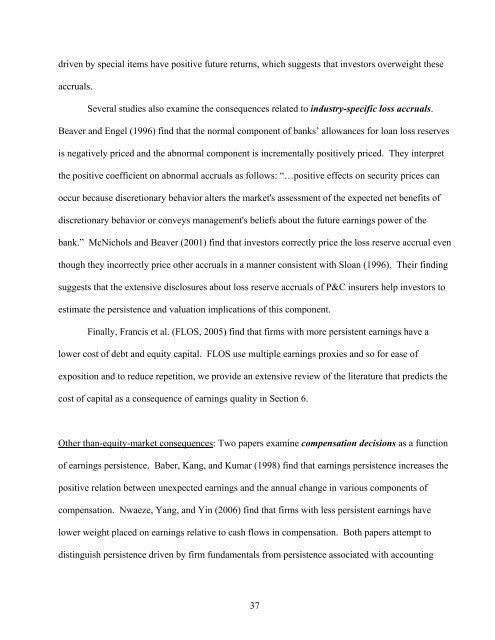Understanding earnings quality - MIT Sloan School of Management
Understanding earnings quality - MIT Sloan School of Management
Understanding earnings quality - MIT Sloan School of Management
You also want an ePaper? Increase the reach of your titles
YUMPU automatically turns print PDFs into web optimized ePapers that Google loves.
driven by special items have positive future returns, which suggests that investors overweight these<br />
accruals.<br />
Several studies also examine the consequences related to industry-specific loss accruals.<br />
Beaver and Engel (1996) find that the normal component <strong>of</strong> banks’ allowances for loan loss reserves<br />
is negatively priced and the abnormal component is incrementally positively priced. They interpret<br />
the positive coefficient on abnormal accruals as follows: “…positive effects on security prices can<br />
occur because discretionary behavior alters the market's assessment <strong>of</strong> the expected net benefits <strong>of</strong><br />
discretionary behavior or conveys management's beliefs about the future <strong>earnings</strong> power <strong>of</strong> the<br />
bank.” McNichols and Beaver (2001) find that investors correctly price the loss reserve accrual even<br />
though they incorrectly price other accruals in a manner consistent with <strong>Sloan</strong> (1996). Their finding<br />
suggests that the extensive disclosures about loss reserve accruals <strong>of</strong> P&C insurers help investors to<br />
estimate the persistence and valuation implications <strong>of</strong> this component.<br />
Finally, Francis et al. (FLOS, 2005) find that firms with more persistent <strong>earnings</strong> have a<br />
lower cost <strong>of</strong> debt and equity capital. FLOS use multiple <strong>earnings</strong> proxies and so for ease <strong>of</strong><br />
exposition and to reduce repetition, we provide an extensive review <strong>of</strong> the literature that predicts the<br />
cost <strong>of</strong> capital as a consequence <strong>of</strong> <strong>earnings</strong> <strong>quality</strong> in Section 6.<br />
Other than-equity-market consequences: Two papers examine compensation decisions as a function<br />
<strong>of</strong> <strong>earnings</strong> persistence. Baber, Kang, and Kumar (1998) find that <strong>earnings</strong> persistence increases the<br />
positive relation between unexpected <strong>earnings</strong> and the annual change in various components <strong>of</strong><br />
compensation. Nwaeze, Yang, and Yin (2006) find that firms with less persistent <strong>earnings</strong> have<br />
lower weight placed on <strong>earnings</strong> relative to cash flows in compensation. Both papers attempt to<br />
distinguish persistence driven by firm fundamentals from persistence associated with accounting<br />
37
















